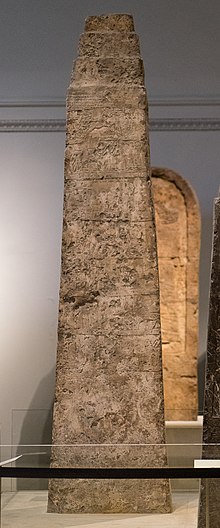White Obelisk
Appearance
| White Obelisk | |
|---|---|
 White Obelisk on display in the British Museum | |
| Material | Limestone |
| Size | Height 284 cm, Width 48 cm |
| Created | 1050-1031 BC |
| Discovered | Nineveh, Iraq |
| Present location | British Museum, London |
| Registration | ME 118807 |
The White Obelisk is a large stone monolith found at the ancient
Assyrian empire, the other being the Black Obelisk of Shalmaneser III. Both are now preserved in the British Museum.[1] The White Obelisk dates to the beginning of the Neo-Assyrian Empire and has been variously ascribed to the reigns of Ashurnasirpal I (c. 1040 BC),[2] Tiglath-Pileser II (c. 950 BC)[3] or Ashurnasirpal II (c. 870 BC).[2]
Discovery
The obelisk was discovered at
Bombay on HMS Akbar in March 1854, arriving in the British capital in February 1855, where it was immediately deposited in the national collection.[4]
Description
The White Obelisk is a very large four-sided pillar made from white
Assyrian art
in existence.
Inscription and reliefs

The preserved part of the inscription at the top of the obelisk describes the Assyrian king as a great
Ishtar
, who was the principal deity of Nineveh.
See also
References
- ^ "British Museum - The White Obelisk". Archived from the original on 2015-01-26. Retrieved 2020-11-07.
- ^ a b c Reade 1975.
- S2CID 161113642.
- ^ British Museum Collection
Bibliography
Wikimedia Commons has media related to White Obelisk.
- Collon, Dominique (1995). Ancient Near Eastern Art. University of California Press. p. 117. ISBN 9780520203075.
- Roaf, Michael (1990). Cultural Atlas of Mesopotamia and the Ancient Near East. Facts on File. ISBN 9780816022182.
- Reade, J. E. (1975). "Aššurnaṣirpal I and the White Obelisk". Iraq. 37 (2): 129–150. S2CID 163342798.
- Reade, Julian (1983). Assyrian Sculpture Julian Reade, British Museum. British Museum Publications. ISBN 9780714120201.
